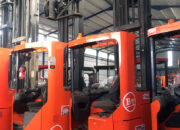5 Warning Signs Your Reachstacker Brake System is Failing — And When to Replace Brake Pads
Meta Description: Don’t wait until brake failure becomes a disaster. Learn the 5 critical warning signs of brake issues on reachstackers and when to replace brake pads for maximum safety and uptime.
Brake Failure = Disaster for Safety and OPEX
What happens if a 60–80 ton reachstacker — currently carrying a 40ft container — suddenly loses braking capability?
This is not a theory. This is real-life risk at ports, ICDs and yard operations.
Brake system integrity on heavy lift equipment (wet disc brakes or hydraulic / pneumatic drum brakes) is one of the most safety-critical systems. They handle extreme load and are directly responsible for safely decelerating multi-million-dollar assets.
Early detection of brake deterioration prevents expensive downtime and protects personnel.
Samcovina — as a leading service and parts solution provider for heavy lift trucks from EU/US/Japan — understands how critical brake system control is.
5 Red Flag Symptoms Your Reachstacker Brakes Are Calling for Help
Never ignore these 5 technical symptoms. They indicate serious brake system failure in progress.
1) Abnormal Noise When Braking (Squealing, Grinding, Scratching)
Description: Extremely loud metallic friction (squeal/grind), or “gravel-like” rubbing noise when brake pedal is applied.
Technical root causes:
Worst case: Brake pads are worn down to backing plate, metal-to-metal contact with rotor
Wet disc brakes: low level, dirty oil, oil contaminated with metal chips → dry friction
Scored / warped rotors or foreign debris (stones) trapped inside brake pack
Impact: destroys rotors / brake pack → extremely high replacement cost; sudden loss of brake torque
2) Brake Pedal Feel Changes (Too Soft, Too Hard, or Vibration)
Soft pedal (“spongy”): pedal travel goes deep before braking torque builds
Hard pedal: requires excessive force to decelerate
Vibrating pedal / steering wheel vibration during braking
Technical root causes:
Soft pedal: hydraulic fluid leak / air in brake line
Hard pedal: seized caliper pistons, clogged line, brake booster (pneumatic) failure
Vibration: warped rotors (typically overheating problem)
Impact: unpredictable stopping distance — no emergency stop capability
3) Truck Pulls to One Side When Braking
Description: When braking (especially hard braking), the unit drifts/pulls to left or right, operator must counter-steer strongly.
Root cause:
Unequal brake torque per axle/wheel
Usually: seized piston on one side, one brake pad wearing faster than the other, or one hydraulic/pneumatic circuit restricted
Impact: extremely dangerous under speed OR when carrying heavy load — high risk of skid or overturn
4) Fluid Leaks (Brake Fluid or Axle / Hub Oil)
Description: Wet/oily stains near wheels, brake calipers or along hose lines.
Technical identification:
Brake fluid (light color): leak from hose or caliper → hydraulic pressure loss
Axle / hub oil (dark, strong smell) — on wet disc brakes, this is the cooling oil → loss causes overheating and burning of brake pack
Impact: sudden brake loss; total destruction of wet disc brake assembly
5) Brake Warning Light on Dash
Description: Brake warning lamp (“(!)” or “BRAKE”) or general fault lamp.
Root cause (ECU reports):
Hydraulic reservoir low level
Brake pad wear sensor reached limit (modern machines)
Hydraulic / pneumatic pressure alarm
Impact: ignoring this is extremely high risk — stop operation immediately
When Is the Correct Timing to Replace Reachstacker Brake Pads?
Many fleets replace brakes “after failure”. Professional fleets replace before failure.
1) Replace Immediately (No Delay)
If any of the above 5 symptoms appear — especially #1 (metal noise), #2 (soft pedal) and #4 (fluid leak) → stop machine.
2) Replace Based on Preventive Maintenance Schedule
This is the optimum method.
Based on operating hours (OEM recommendation, e.g. 5,000h / 10,000h)
Depends on operation condition (marine corrosion, aggressive braking cycles)
Pro tip: Do not only count hours — always combine with visual inspection during PM service (oil / filters service interval)
3) Replace When Visual Inspection Confirms
During PM service technicians check:
Remaining friction material thickness (<20–25% = replace)
Pad condition: cracked, glazed (overheat), uneven wear (caliper piston sticking)
The Cost of Delay: “Saving” Becomes “Burning Money”
Trying to “save cost” by delaying pad replacement is a major financial mistake.
Rotor / wet disc pack replacement = 10x–20x the cost of pads
Downtime cost: emergency shutdown disrupts port/ICD logistics
Safety & liability risk: even minor collision → huge legal exposure







